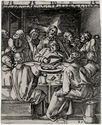
19th, 20th & 21st Century Fine Prints
707-546-7352 · fax 707-546-7924 · web: www.annexgalleries.com · email: artannex@aol.com
Marcantonio Raimondi Biography
Marcantonio Raimondi
Italian
1470–1534
Biography
As with many Renaissance artists, the exact birth and death dates of wood engraver Marcantonio Raimondi are unknown. He was born between 1470 and 1482 in Bologna, Italy. His training began in the workshop of painter and goldsmith Francesco Francia, where he created several of the engraving techniques he would later apply to the block. Living in Bologna at the time that both Albrecht Durer and Michelangelo were working there in the early 1510s, he often copied their styles (and Durer's cut-and-paste technique) to improve his own work, as was common practice among artists at the time. However, Raimondi's copied works included the "AD" monogram of Durer, which would lead to the first intellectual property lawsuit in Italian art history.
Raimondi traveled to Rome around 1510 and his work started to exhibit the influence of Raphael, who, impressed with Raimondi's reproduction of a portion of Michelangelo's painting Battle of Cascia, began to train the younger artist. They opened their own printmaking studio which soon evolved into an engraving school, led by Raimondi. They would train some of Italy's leading artists, including Giovanni Caraglio, Marco Dente, and Agostino de Musi. Of note with regards to his reproductive work, Rainmondi would often borrow imagery from sketches rather than finished works of famous artists.
In the early 1520s Rainmondi created a suite of sixteen erotic images, accompanied by sonnets written by the poet Pietro Aretino, done after the paintings by Giulio Romano. He was imprisoned by Pope Clement VII, only to be released at the interseccion of friends in the church and influential artists. He continued to work until 1527, when he was forced into poverty during the 'Sack of Rome' and had to flee the city. It is unknown where he lived until his death around 1534, though some sources place him in Venice.
To this day the work of Marcantonio Raimondi is considered among the foremost influential reproductive artist, his copies allowing for the disemination of major artworks into the homes of the middle class. He was also intrumental in improving the engraving techniques for reproduction.

